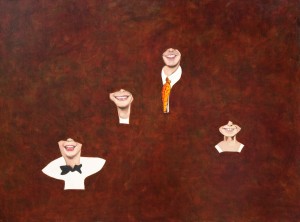Contact: john@schuermanfineart.com 612-240-2317
Exhibition Concept:
World Population has more than doubled since 1960. The purpose of this exhibit is to present a collection of artwork on the issue of overpopulation and to sponsor dialogue that helps people understand and engage with the many global effects.
In 2011 the planet passed 7 billion with a conservative estimate for passing 9 billion by 2050 – three times the population of 1960.[1] Currently every passing hour brings an additional nine thousand people to the planet (net gain: births minus deaths). That’s like adding another Chicago plus Los Angeles to the planet every month. Today, the effects of overpopulation are visible: declining resources and resource conflicts (food and water shortages, topsoil and farmland loss, declining oil, overgrazing, desertification, etc.), species extinction, increasing poverty, and others. According to Global Footprint data, the world is already significantly overpopulated above truly sustainable levels. And yet, overpopulation remains a taboo topic.
The exhibition includes three components:
- Five featured artists, with multiple works that directly address overpopulation and its effects.
- An informational installation –facts, statistics, diagrams, etc.
- Recommendations for local programming for conversations about the exhibit
Why: The public discourse around population is skittish at best. It is safe to discuss the effects of overpopulation – sustainability, water supply, etc. – but discussion of over-population and especially action to limit population growth is taboo. Consequently, the statistical data, scientific predictions, as well as anecdotal situations have not reached much of a public. Meanwhile, billions of people suffer lack of clean water, resources are depleted, and species are going extinct at a rate hundreds of times faster than before the industrial revolution.
What others won’t talk about is a perfect call to action for artists. Politically sensitive topics, and in particular, social causes are almost always ushered in with artistic support, for example the folk singers that supported the civil rights movement. Furthermore, art is perfect for starting to talk about things we haven’t figured out how to address, and where there is no clear answer, or even articulation.
Press Links:
Video interview with John
Star Tribune article
Space requirements 1500 – 2,000 s.f. + ceiling height at least 12 f.
Costs: Circulation fee: $6000 + Shipping and travel as needed. Two of the installations require the artist to install. Est. $1500 per artist (2) to travel and install. Includes the 5 installations; 10 framed drawings; 3 large scale paintings, 1 video, and several informational displays.
Original Show Dates
April – May 2014
Bloomington Theater and Art Center
Bloomington, MN
June – July 2014
Cargill Gallery
Hennepin County Central Public Library
Minneapolis, MN
Available: 2016 and future
The Featured Artists and their work:
Michael Kareken – www.michaelkareken.com
Michael Kareken is an urban landscape artist that brings us face to face with the continuous stream of refuse generated in daily life. At first glance his large-scale paintings show us overconsumption, waste, pollution, recycling, and the simple magnitude of the piles left behind. On a deeper level, the multitude discarded objects are, in Kareken’s words, ‘stand-ins for us’. The many colors of high and low-brow leftovers, and the individual stories of each glass bottle or cardboard box produce a landscape populated by diverse individual personalities, albeit just trash.
Mayumi Amada – www.mnartists.org/Mayumi_Amada
Mayumi Amada is an installation artist and sculptor pondering the meaning of life and mortality in the eternal flow of time. She brings a Zen-Buddhist perspective to this exhibition, helping us respect the present moment as part of our descendents’ future. She typically works with recycled materials –plastic bottles, egg cartons etc. and transforms these into beautiful garden-like environments that eerily have no natural elements. Reuse leads to rebirth, and we are left to question the sufficiency of our actions for the future.
John Schuerman – www.schuermanfineart.com
John Schuerman paints and draws the essential patterns of nature and our juxtaposing human activity. Through his portraits of the family unit, the multiplying effects of propagation, and the tension of human concepts with natural order Schuerman reminds us that our most basic values, concepts, and production of any sort are complicit with the population problem.
Jim Proctor – http://www.mnartists.org/artistHome.do?rid=7438
Jim Proctor uses a field-science approach for creating art. He collects and manipulates botanical specimens by grafting them together to give them new powers, and ‘to protect them’. The works remind us of lost species, like a walk through a natural history museum, and of the fragile nature of the elements in our natural environment.
Karen Shragg –
Karen Shragg is an activist, poet, and naturalist who has worked on overpopulation for decades. She combines artefacts from the nature center that she runs in Richfield, MN with machines, tools and statistics to make installations about ‘the numbers’.
Tip Floor by Michael Kareken
[1] United Nations Department of Economics and Social Affairs/Population Division, ‘World Population to 2300’.








